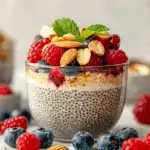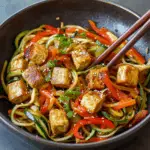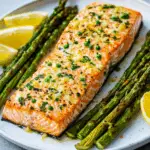Grilled pineapple slices are a simple and delicious way to elevate fresh fruit with a warm, caramelized flavor. Perfect for summer cookouts or as a tropical dessert, this recipe brings out the natural sweetness of pineapple while adding a smoky char that’s irresistible.
FULL RECIPE
Ingredients
- 1 fresh pineapple, peeled, cored, and cut into 1/2-inch thick slices
- 2 tablespoons brown sugar
- 1 tablespoon honey
- 1 tablespoon melted butter
- 1/2 teaspoon ground cinnamon
- Pinch of salt
Directions
- Preheat grill to medium-high heat.
- In a small bowl, mix brown sugar, honey, melted butter, cinnamon, and salt until combined.
- Brush the mixture generously over both sides of the pineapple slices.
- Place pineapple slices on the grill and cook for 3–4 minutes per side, or until grill marks appear and the pineapple is lightly caramelized.
- Remove from grill and serve warm.
Nutritional Information
- Calories: 90
- Carbohydrates: 22g
- Sugars: 19g
- Fat: 2g
- Protein: 0.5g
- Fiber: 1g
The History and Origins of Grilled Pineapple
Grilled pineapple has roots in tropical regions where pineapples grow abundantly, such as Hawaii, the Caribbean, and parts of Central and South America. The practice of grilling pineapple likely evolved as a way to enhance its natural sweetness and add a smoky flavor. Many traditional island cuisines use grilled pineapple in both savory and sweet dishes, showcasing its versatility.
The Science Behind Grilling Pineapple
When pineapple is grilled, the heat causes caramelization of the natural sugars on its surface, resulting in a golden-brown color and deeper, richer flavor. This process, called the Maillard reaction, creates complex taste notes that balance sweetness with a slight char and smokiness. Additionally, grilling softens the fruit’s texture, making it juicier and more tender.
Choosing the Right Pineapple
Selecting a ripe pineapple is crucial for the best grilled results. A ripe pineapple will have a sweet aroma at the base, firm but slightly yielding flesh, and vibrant green leaves. Avoid pineapples that are too soft or have brown spots, as these may be overripe or starting to ferment, which can affect flavor and texture when grilled.
Health Benefits of Pineapple
Pineapple is rich in vitamins, especially vitamin C, which supports the immune system and promotes skin health. It also contains bromelain, an enzyme that aids digestion and has anti-inflammatory properties. Grilling does not diminish these nutrients significantly, making grilled pineapple a healthy and tasty treat.
Enhancing Flavor with Spices
Adding spices such as cinnamon or nutmeg to grilled pineapple elevates the taste by introducing warm, aromatic notes. These spices complement the fruit’s natural sweetness and add depth to the overall flavor profile. Experimenting with different spices can create unique variations of the classic grilled pineapple recipe.
Using Honey and Brown Sugar
Honey and brown sugar are often used in grilled pineapple recipes to intensify caramelization. Honey provides a floral sweetness and sticky glaze, while brown sugar adds a rich molasses undertone. Both help create a glossy, appealing finish on the pineapple slices after grilling.
Butter’s Role in Grilled Pineapple
Brushing melted butter on pineapple before grilling adds moisture and richness. It also helps the spices and sugars adhere better to the fruit, promoting even caramelization. The buttery flavor blends beautifully with the tropical sweetness of pineapple, enhancing the overall taste experience.
How to Grill Pineapple on Different Types of Grills
Grilled pineapple can be cooked on charcoal, gas, or electric grills. Charcoal grills impart a smoky aroma that pairs perfectly with pineapple’s sweetness. Gas grills offer consistent heat and ease of control, while electric grills provide convenience for indoor cooking. Adjust grilling times slightly depending on the heat source to avoid overcooking.
Alternatives to Grilling: Pan-Seared Pineapple
If a grill is unavailable, pan-searing pineapple slices in a hot skillet with butter and spices can mimic the grilling effect. This method caramelizes the sugars and softens the fruit but lacks the smoky notes imparted by an open flame. It’s a great option for quick preparation and indoor cooking.
Pairing Grilled Pineapple with Other Foods
Grilled pineapple pairs exceptionally well with a variety of foods. It complements grilled meats like pork, chicken, and seafood by adding sweetness and acidity that balance savory flavors. It also works well in salads, tacos, or as a topping for burgers, providing a tropical twist to many dishes.
Grilled Pineapple in Desserts
Using grilled pineapple in desserts adds complexity and a smoky-sweet contrast to traditional fruit preparations. It can be served alongside ice cream, used as a topping for cakes and tarts, or blended into smoothies for a caramelized flavor boost. The warmth of the fruit contrasts nicely with cold or creamy elements.
Grilled Pineapple and Tropical Cocktails
Grilled pineapple makes a fantastic addition to tropical cocktails like piña coladas or mojitos. Its smoky sweetness enhances the fruitiness of the drinks and adds a subtle depth of flavor. Pineapple chunks or juice from grilled slices can be used to create refreshing and unique beverages.
Storing and Reheating Grilled Pineapple
Grilled pineapple can be stored in an airtight container in the refrigerator for up to three days. To reheat, simply warm it briefly in a skillet or microwave. Avoid overcooking during reheating to maintain the tender texture and juicy interior.
Grilled Pineapple for Special Diets
Grilled pineapple is naturally gluten-free, vegan, and low in calories, making it suitable for many special diets. The recipe’s simple ingredients allow easy modification for sugar-free or low-carb variations by adjusting or omitting sweeteners.
Using Grilled Pineapple in Meal Prep
Including grilled pineapple in meal prep adds flavor variety and nutritional benefits. It can be prepared in bulk and used throughout the week as a snack, dessert, or component in main dishes, making healthy eating more enjoyable and convenient.
Common Mistakes to Avoid When Grilling Pineapple
One common mistake is grilling pineapple on too high heat, which can cause burning before the fruit softens. Another is using underripe pineapple, which may remain tough and sour. Avoid overcrowding the grill to ensure even cooking and proper caramelization.
Creative Variations of Grilled Pineapple
Experimenting with toppings like shredded coconut, chopped nuts, or fresh mint can add texture and flavor contrasts to grilled pineapple. Marinating the slices in citrus juice or rum before grilling introduces new flavor dimensions and enhances sweetness.
Cultural Significance of Pineapple in Cuisine
Pineapple is often considered a symbol of hospitality and warmth in many cultures. Grilled pineapple dishes reflect this cultural appreciation by turning a simple fruit into a flavorful and welcoming treat shared among friends and family.
Environmental Impact of Pineapple Farming
Pineapple cultivation can have environmental consequences including deforestation and pesticide use. Choosing sustainably sourced pineapples helps support eco-friendly farming practices and reduces the ecological footprint associated with the fruit.
Conclusion
Grilled pineapple is a versatile, flavorful, and nutritious dish that brings a tropical touch to any meal. Its sweet caramelized flavor, combined with smoky char, makes it suitable for a wide range of culinary uses from savory pairings to sweet desserts and refreshing beverages. By understanding its origins, health benefits, and preparation techniques, you can elevate this simple fruit into a gourmet experience that delights the palate and nourishes the body. Whether grilled outdoors on a sunny day or seared indoors for a quick treat, grilled pineapple offers endless opportunities to explore flavors and impress guests with a dish that’s as beautiful as it is delicious.






